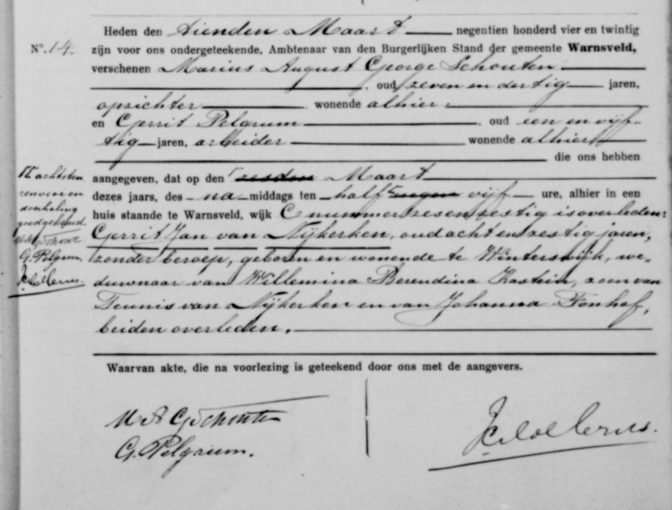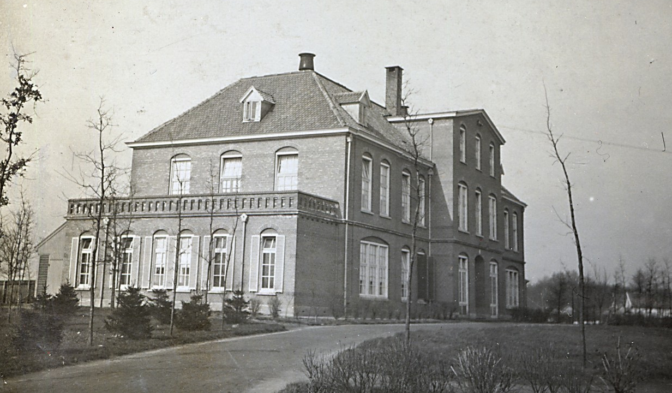Learning how to analyze a record is one of the most valuable skills we need to learn as a genealogist. To give you an example of how this works, let’s take a look at the death record of my second great-grandfather Gerrit Jan van Nijkerken.

Abstract:
Warnsveld, 10 March 1924.
Marinus August George Schoute, 37, overseer, living here, and Gerrit Pelgrum, 51, laborer, declare that on eight [corrected from six] March 1924 at 5.30 PM [corrected from 8.30 PM] died in a house in Warnsveld ward C number 66 Gerrit Jan van Nijkerken, age 68, without occupation, born and living in Winterswijk, widower of Willemina Berendina Kastein, son of Teunis van Nijkerken en van Johanna Fonhof, both deceased.[signed]
M A G Schoute
G Pelgrum1
By analyzing this record and its contents, we can determine how reliable the different pieces of information are.
Original versus derivative
The record is signed by the informants, showing that it is the original record and not a later copy. What we have is a scan of a microfilm of an original record, created two days after the death. The image is legible and provides us with the same information as the original (paper) record, so in terms of evidence analysis we treat this as an original record.
Primary versus secondary
We know who the informants were: Marinus August George Schoute and Gerrit Pelgrum. For each piece of information in the record, we can analyze whether they would have primary (first-hand) knowledge, or secondary (hear-say).
- Regulations regarding who could register a death required informants to have personal knowledge that the death had taken place. This implies that any information about Gerrit Jan’s death, such as the date and the place, is primary information.
- Schoute and Pelgrum were younger than Gerrit Jan, and lived in a different place than the official residence of Gerrit Jan. They were not around when he was born and it is unlikely that they knew his family. The information that they gave about his age, deceased wife and parents is probably secondary.
Direct or indirect
Whether the information that this record provides is direct or indirect evidence depends on the research question.
- The record provides direct evidence to answer the question “When and where was Gerrit Jan van Nijkerken born?” since it lists his age and place of birth. He was born in Winterswijk between 7 March 1857 and 6 March 1858. The record does not give an exact answer, but it does directly address the question.
- The record provides direct evidence to answer the question “When and where did Gerrit Jan van Nijkerken die?” He died in Warnsveld on 6 March 1924.
- The record provides direct evidence to answer the question “What was Gerrit Jan van Nijkerken’s place of residence at the time of his death?” He was living in Winterswijk.
- The record provides indirect evidence to the question “Why did Gerrit Jan van Nijkerken die in Warnsveld, even though he lived in Winterswijk?” Gerrit Jan’s age of 68 suggests he would not be routinely travelling the 30 miles/45 km that separate Winterswijk from Warnsveld. The first informant was an overseer, which suggests that Gerrit Jan van Nijkerken may have been in an institution. A stay in a hospital or prison would explain why he died away from home. Given his age, a hospital seems more likely. This is indirect evidence because the record in itself does not give us the answer. We must use our imagination to see the possibilities implied by the record and need to combine it with information from other sources to find the answer.
Just because evidence is direct does not mean it is correct, especially if it is based on secondary information. We will need to compare the information with other records before we can come to a conclusion.
Independence of the record
When correlating information from multiple sources, it is important to verify that the sources are independent, meaning that they cannot be traced back to the same source of information. Records that are not independent do not corrobarate each other but merely duplicate each other.
It is unlikely that the informants knew Gerrit Jan’s family, so the fact that they were able to name his former spouse and parents suggests they may have had access to a source that provided them with that information. It is possible that they brought along Gerrit Jan’s marriage booklet. This means that the information about his spouse and parents may not be independent from his marriage record. Additional research is needed to verify that information.
Why did he die in Warnsveld?
Close analysis of this record turned up an important open end: why did Gerrit Jan die in Warnsveld while he lived in Winterswijk? Was he in an institute, perhaps a hospital?
A literature search showed that Warnsveld had a psychiatric hospital that treated people from the entire region. Research in patient records of that hospital showed that Gerrit Jan van Nijkerken was a patient there. He was committed there on 31 August 1923 by order of the court, at the request of his son Gerhard.2
The patient record does not give any medical information . Research in court records may provide us with more information about Gerrit Jan’s condition. Given his age, it is possible that he suffered from dementia or Alzheimer’s. He was in the hospital for over six months before he passed away.
Without a detailed analysis of this death record, I would never have thought to look for these records. I would not have learned where he spent the last months of his life, and would not have known about the court case committing him to the psychiatric facility.

Psychiatric hospital in Warnsveld. Credits: Regionaal Archief Zutphen (Public Domain)
- Warnsveld, Gelderland, Netherlands, death record 1924 no. 14, Gerrit Jan van Nijkerken, 10 March 1924; consulted as “Personen,” index and digital images, Gelders Archief (http://www.geldersarchief.nl : accessed 3 May 2016).
- Oude en Nieuwe Gasthuis (Warnsveld, Gelderland), register of patients, 1922-1924, call number 1002, entry 5791, Gerrit Jan van Nijkerken; consulted as “Voorouders,” index and digital images, Regionaal Archief Zutphen (http://regionaalarchiefzutphen.nl : accessed 3 May 2016).


Hi,
In footnote 1, you wrote: consulted as “Personen,”
Why is that?
Thanks,
Fred
That identifies the section of the website where I found the information; similar to citing a chapter in a book.
If you cite an original source that had been imaged and published online, citations usually have two layers: one that identifies the original source and one that identifies where you consulted it. The book Evidence Explained describes how to cite such sources and is the standard for citations as recommended by the Board for Certification of Genealogists.